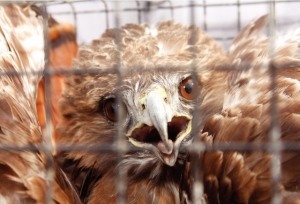Veterinarians wait for band data from hawk
By Josh Ellerbrock
Published in News on February 6, 2013 1:46 PM

News-Argus/BOBBY WILLIAMS
This adult red-tailed hawk was rescued earlier this month after it was seen sitting next to a wood line off Emmaus Church Road. The hawk was spotted by several local residents and reported to the Wayne County Animal Control Office.
A red-tailed hawk captured last Tuesday near Emmaus Church Road in Dudley has seen better days.
The hawk was spotted by several area residents, who contacted the Wayne County Animal Control. Officer Graham Price responded to the scene to assist in catching the bird and managed to do so without injuring it further.
Confined to a cage with a broken wing, the hawk has been sent to the Animal Hospital of Lenoir County for local treatment. Veterinarians there determined that the hawk's broken right wing, probably caused by a hard impact that popped the wing joint out, has been a chronic problem for the hawk.
"He has some control but not enough to pick himself up. He's been fighting to stay alive for a while," veterinarian Kirby Harris said.
Other than the broken wing, the hawk is in decent shape with sharp plumage for a grounded bird. The injury, however, is beyond repair, Harris said.
The Animal Hospital of Lenoir County has contacted other local rehabilitators to house the hawk, but none with a federal permit to take care of hawks has any room to hold the animal, considering the hawk's wing would make it impossible to rehabilitate for the wild.
"Nobody has a place for him, unfortunately," Harris said.
There have been times when a chronically injured hawk has been placed after a rehabilitator has heard of the animal. But more often than not, the bird is euthanized. The prevalence of red-tailed hawks and federal regulations that require the animal's near-perfect condition for education purposes mean that red-tailed hawks don't have a high survival rate once injured.
Before anything can be done with the bird, the clinic has to check with the Bird Banding Laboratory, which is run by the U.S. Geological Survey, which will tell them more about its history. That could take a week or two.
"We have no idea what's going to happen yet," said Jennifer Feebode, a vet tech at the Animal Hospital.
Close to 1.9 million hawks are registered with the laboratory.
The permit on the band on the red-tailed hawk has been inactive since August 2012. The bird was originally captured by an independent bander at Millers Gap in Pennsylvania, a point three miles away from Mechanicsburg, Pa., as part of a monitoring project. It was trapped in October 2005 and was considered a young red-tailed hawk, or under 6 1/2 years old, when it was originally banded.
If given the go ahead by the bird banding laboratory, the hawk could be used as a part of medical education by local animal rehabilitators and veterinarians. The clinic will use an isoflurane box (imagine a Tupperware box pumped with a gas that induces unconsciousness) to aid veterinarians in learning how to place catheters into the hawk.
Harris said the hawk won't feel anything during the process.
If there are any federally permitted hawk rehabilitators with room for the red-tailed hawk, they are encouraged to contact the Animal Hospital of Lenoir County at 252-566-3090.
